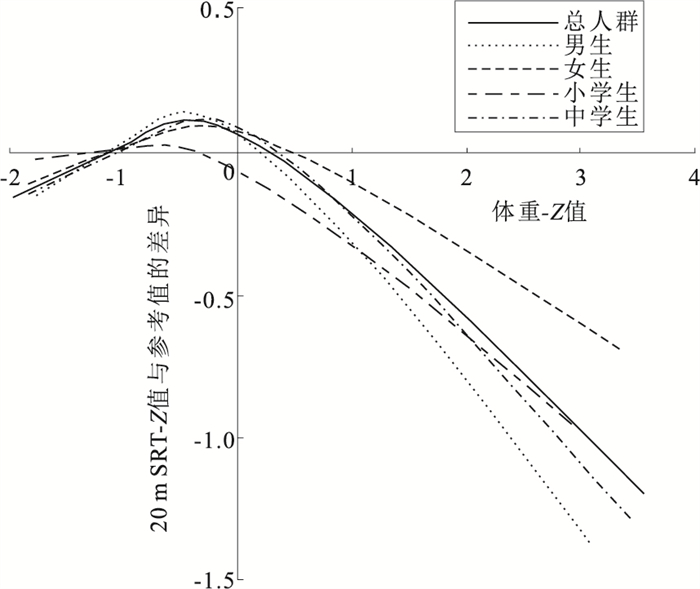Relationship between anthropometric parameters and 20-meter shuttle run test among children and adolescents
-
摘要:
目的 探讨儿童青少年体格发育指标与20 m往返跑(20 m SRT)成绩间的关联, 为促进儿童青少年健康发展提供科学依据。 方法 采用方便抽样方法, 于2019年4-5月按照街道、学校类型在深圳市宝安区抽取3 192名中小学生, 通过体格测量和问卷调查的形式获取儿童青少年身高、体重、20 m SRT成绩及一般人口统计学指标。采用限制性立方样条分别分析不同体格发育指标[身高-Z值、体重-Z值和体质量指数(BMI)-Z值]与20 m SRT成绩的剂量-反应关系, 据此分别将身高-Z值、体重-Z值和BMI-Z值分成两组; Spearman相关分析身高-Z值与20 m SRT-Z值间的相关性; 采用Logistic回归模型分析不同人体测量指标与20 m SRT成绩的关系。 结果 体重-Z值、BMI-Z值与20 m SRT-Z值间分别呈非线性剂量-反应关系(P值均 < 0.01), 身高-Z值与20 m SRT-Z值间呈线性相关(r=0.06, P < 0.05)。儿童青少年20 m SRT-Z值低等级检出率为44.7%, 且性别、学段间差异均有统计学意义(χ2值分别为14.02, 93.28, P值均 < 0.01)。身高-Z值与20 m SRT-Z值等级间在总人群、不同性别、不同学段儿童青少年中关联均无统计学意义(P值均>0.05);体重-Z值>-0.23与20 m SRT-Z值低等级有关; BMI-Z值>0.25与20 m SRT-Z值低等级相关(OR值分别为0.61, 0.45, P值均 < 0.01);对性别、学段分别分层后, 体重-Z值、BMI-Z值与20 m SRT-Z值等级间的负向关联仍有统计学意义(P值均 < 0.01)。 结论 高身高-Z值与20 m SRT-Z值等级增加无关, 高体重-Z值、BMI-Z值与20 m SRT-Z值等级增加有关。基于体重和BMI视角采取相关措施以提高儿童青少年心肺耐力水平在某种程度上可能更有效。 Abstract:Objective To determine the association between anthropometric parameters and 20-meter shuttle run test (20 m SRT) score among children and adolescents. Methods The convenient sampling method was conducted to select 3 192 primary and secondary school students in Baoan District, Shenzhen, based on the street-school types-school from April to May 2019.Height, weight, 20 m SRT score and general demographic indicators were assessed and collected.Individuals were divided into two groups based on the dose-response correlation between different anthropometric parameters (the Z-score of height, weight and BMI) and 20 m SRT score analyzed with the restricted cubic spline.The association between the Z-score of height and 20 m SRT score was further analyzed using the Spearman correlation analysis.Logistic regression analysis was used to analyze separately the relationship different anthropometric parameters and 20 m SRT score. Results The Z-value of weight and 20 m SRT score showed a non-linear dose-response association (P < 0.01), the significant but weak linear correlation between the Z-value of height and 20 m SRT score (r=0.06, P < 0.05).The prevalence rate on the low-level of the Z-value of 20 m SRT score in 3 192 children and adolescents was 44.7%, and the gender (χ2=14.02, P < 0.01) and grade difference (χ2=93.28, P < 0.01) were both statistically significant.There was no significant relationship between the Z-value of height and 20 m SRT score grade among total population, different genders and different grades (P>0.05).Compared with the reference group on the Z-value of weight ≤-0.23, individuals with the Z-value of weight >-0.23 had the low-level of 20 m SRT score (OR=0.61, P < 0.05).Compared with the reference group on the Z-value of BMI ≤0.25, individuals with the Z-value of weight >0.25 had the low-level of 20 m SRT score (OR=0.45, P < 0.05).Stratified for gender and grade, the above significant relationship on the Z-value of weight, Z-value of BMI and 20 m SRT score were still observed (P < 0.01). Conclusions The higher height Z-value shows on correlations with 20 m SRT score, but the positive association is found between weight and BMI Z-value and the 20 m SRT score.The cardiopulmonary fitness improvement may be more effective among children and adolescents when tuking weight and BMI Z scores into consideration. -
Key words:
- Body height /
- Body weight /
- Body mass index /
- Running /
- Regression analysis /
- Child /
- Adolescent
1) 利益冲突声明 所有作者声明无利益冲突。 -
表 2 不同性别学段儿童青少年体格发育指标及20 m SRT-Z值等级分布比较
Table 2. Comparison of the distribution of anthropometric indicators and 20 m SRT-Z values in different gender groups
组别 选项 人数 统计值 身高-Z值 体重-Z值 BMI-Z值 20 m SRT-Z值等级 ≤-0.13 >-0.13 ≤-0.23 >-0.23 ≤0.25 >0.25 低 高 性别 男 1 731 855(49.4) 876(50.6) 883(51.0) 848(49.0) 1 115(64.4) 616(35.6) 722(41.7) 1 009(58.3) 女 1 461 749(51.3) 712(48.7) 724(49.6) 737(50.4) 964(66.0) 497(34.0) 706(48.3) 755(51.7) χ2值 1.11 0.67 0.86 14.02 P值 0.29 0.41 0.35 < 0.01 学段 小学 1 599 893(55.8) 706(44.2) 895(56.0) 704(44.0) 1 091(68.2) 508(31.8) 851(53.2) 748(46.8) 中学 1 593 711(44.6) 882(55.4) 712(44.7) 881(55.3) 988(62.0) 605(38.0) 577(36.2) 1 016(63.8) χ2值 40.15 40.59 13.55 93.28 P值 < 0.01 < 0.01 < 0.01 < 0.01 注: ()内数字为构成比/%。 表 3 青少年不同体格发育指标水平与20 m SRT-Z值等级关联[O值(95%CI)]
Table 3. The relationship between different anthropometric parameters and the grades of 20 m SRT-Z value among adolescents [OR(95%CI)]
自变量 选项 总人群(n=3 192) 性别 学段 男生(n=1 731) 女生(n=1 1461) 小学(n=1 599) 中学(n=1 593) 身高-Z值 >-0.13 1.04(0.88~1.22) 0.99(0.79~1.24) 1.06(0.84~1.34) 1.04(0.83~1.31) 0.94(0.74~1.18) 体重-Z值 >-0.23 0.61(0.52~0.72)** 0.53(0.42~0.66)** 0.71(0.56~0.89)** 0.57(0.46~0.72)** 0.60(0.47~0.76)** BMI-Z值 >0.25 0.45(0.38~0.53)** 0.37(0.29~0.47)** 0.57(0.44~0.73)** 0.37(0.29~0.48)** 0.51(0.40~0.65)** 注: **P < 0.01。 -
[1] PETROVICS P, SANDOR B, PALFI A, et al. Association between obesity and overweight and cardiorespiratory and muscle performance in adolescents[J]. Int J Environ Res Public Health, 2020, 18(1): 134. doi: 10.3390/ijerph18010134 [2] MARKOVIĈ L, TRBOJEVIĈ JOCIĈ J, HORVATIN M, et al. Cardiorespiratory fitness and health-related quality of life in secondary school children aged 14 to 18 years: a cross-sectional study[J]. Healthcare (Basel), 2022, 10(4): 660. [3] 中国学生体质与健康研究组. 2005年中国学生体质与健康调研报告[M]. 北京: 高等教育出版社, 2007.Chinese Student Constitution and Health Research Group. Report on the physical fitness and health research of Chinese school student[M]. Beijing: Higher Education Press, 2007. (in Chinese) [4] VAINSHELBOIM B, MÜLLER J, LIMA R M, et al. Cardiorespiratory fitness, physical activity and cancer mortality in men[J]. Prev Med, 2017, 100: 89-94. doi: 10.1016/j.ypmed.2017.04.014 [5] ÁLVAREZ-BUENO C, HILLMAN C H, CAVERO-REDONDO I, et al. Aerobic fitness and academic achievement: a systematic review and Meta-analysis[J]. J Sports Sci, 2020, 38(5): 582-589. doi: 10.1080/02640414.2020.1720496 [6] TOMKINSON G R, LANG J J, TREMBLAY M S. Temporal trends in the cardiorespiratory fitness of children and adolescents representing 19 high-income and upper middle-income countries between 1981 and 2014[J]. Br J Sports Med, 2019, 53(8): 478-486. doi: 10.1136/bjsports-2017-097982 [7] RAMÍREZ-VÉLEZ R, GARCÍA-HERMOSO A, ALONSO-MARTÍ-NEZ A M, et al. Cardiorespiratory fitness normative values in Latin-American adolescents: role of fatness parameters[J]. Int J Environ Res Public Health, 2019, 16(20): 3889. doi: 10.3390/ijerph16203889 [8] KOLUNSARKA I, GRÅSTEN A, HUHTINIEMI M, et al. Development of children's actual and perceived motor competence, cardiorespiratory fitness, physical activity, and BMI[J]. Med Sci Sports Exerc, 2021, 53(12): 2653-2660. doi: 10.1249/MSS.0000000000002749 [9] LANG J J, TREMBLAY M S, ORTEGA F B, et al. Review of criterion-referenced standards for cardiorespiratory fitness: what percentage of 1 142 026 international children and youth are apparently healthy?[J]. Br J Sports Med, 2019, 53(15): 953-958. doi: 10.1136/bjsports-2016-096955 [10] TOMKINSON G R, LANG J J, TREMBLAY M S, et al. International normative 20 m shuttle run values from 1 142 026 children and youth representing 50 countries[J]. Br J Sports Med, 2017, 51(21): 1545-1554. doi: 10.1136/bjsports-2016-095987 [11] 中国学生体质与健康研究组. 2014年中国学生体质与健康调研报告[M]. 北京: 高等教育出版社, 2016.Chinese Student Constitution and Health Research Group. Report on the physical fitness and health research of Chinese school student[M]. Beijing: Higher Education Press, 2016. (in Chinese) [12] 郑冬华, 毕存箭, 尹小俭, 等. 中国日本儿童青少年体质量指数与心肺耐力的关系[J]. 中国学校卫生, 2019, 40(11): 1620-1623, 1628. doi: 10.16835/j.cnki.1000-9817.2019.11.006ZHENG D H, BI C J, YIN X J, et al. Relationship between body mass index and cardiorespiratory fitness in Chinese and Japanese children and adolescents[J]. Chin J Sch Health, 2019, 40(11): 1620-1623, 1628. (in Chinese) doi: 10.16835/j.cnki.1000-9817.2019.11.006 [13] ORTEGA F B, RUIZ J R, CASTILLO M J, et al. Physical fitness in childhood and adolescence: a powerful marker of health[J]. Int J Obes (Lond), 2008, 32(1): 1-11. doi: 10.1038/sj.ijo.0803774 [14] MATTON L, THOMIS M, WIJNDAELE K, et al. Tracking of physical fitness and physical activity from youth to adulthood in females[J]. Med Sci Sports Exer, 2006, 38(6): 1114-1120. doi: 10.1249/01.mss.0000222840.58767.40 [15] MARTIN-SMITH R, COX A, BUCHAN D S, et al. High intensity interval training (HⅡT) improves cardiorespiratory fitness (CRF) in healthy, overweight and obese adolescents: a systematic review and Meta-analysis of controlled studies[J]. Int J Environ Res Public Health, 2020, 17(8): 2955. doi: 10.3390/ijerph17082955 [16] SHANG X, LIU A, LI Y, et al. The association of weight status with physical fitness among Chinese children[J]. Int J Pediatr, 2010, 2010: 515414. [17] KREBS N F, HIMES J H, JACOBSON D, et al. Assessment of child and adolescent overweight and obesity[J]. Pediatrics, 2007, 120(Suppl 4): S193-S228. [18] LIAO Y, CHANG S H, MIYASHITA M, et al. Associations between health-related physical fitness and obesity in Taiwanese youth[J]. J Sports Sci, 2013, 31(16): 1797-1804. doi: 10.1080/02640414.2013.803588 [19] XU Y, MEI M, WANG H, et al. Association between weight status and physical fitness in Chinese mainland children and adolescents: a cross-sectional study[J]. Int J Environ Res Public Health, 2020, 17(7): 2468. doi: 10.3390/ijerph17072468 [20] PRISTA A, MAIA J A, DAMASCENO A, et al. Anthropometric indicators of nutritional status: implications for fitness, activity, and health in school-age children and adolescents from Maputo, Mozambique[J]. Am J Clin Nutr, 2003, 77(4): 952-959. doi: 10.1093/ajcn/77.4.952 [21] TOMKINSON G R, CARVER K D, ATKINSON F, et al. European normative values for physical fitness in children and adolescents aged 9-17 years: results from 2 779 165 Eurofit performances representing 30 countries[J]. Br J Sports Med, 2018, 52(22): 1445-14563. doi: 10.1136/bjsports-2017-098253 [22] YIN X, ZHANG F, SUN P, et al. The multistage 20-meter shuttle run test reference values for Tibetan children and adolescents in Tibet, China[J]. Int J Environ Res Public Health, 2022, 19(19): 12703. doi: 10.3390/ijerph191912703 -







 下载:
下载:


